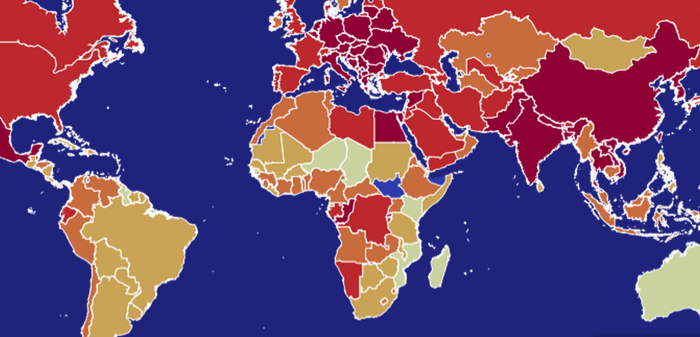Digital Cartography
a.k.a. How to make maps for journalism
Jacopo Ottaviani – @JacopoOttaviani
ICFJ Knight Fellow, data editor at Code for Africa


Bonne, R. – Antique map of Spain and Portugal
We will make maps.
From «conception» to «publication»
These lectures will be:
-
Practical (we'll get our hands dirty)
-
Realistic (we'll recreate typical production scenarios)
-
Dynamic (feel free to interrupt... ask questions!)
Interact, ask, experiment... and enjoy

The Fra Mauro map, "considered the greatest memorial of medieval cartography", is a map of the world made around 1450 by the Italian cartographer Fra Mauro. The map is a map of the world and includes Asia, the Indian Ocean, Africa, Europe and the Atlantic. The map is oriented with south at the top.
Let's start.
The role of data
Data should be seen as a force multiplier in the newsroom (cit. Aron Pilhofer, The Guardian)
Something empowering the existing processes of journalistic production and storytelling.

In other words, data should:
- Integrate stories
- Strengthen stories
- Enhance stories
- Provide context
- Prove facts
- Debunk myths
- Generate stories

courtesy of @AlbertoCairo
It's about questions:
- Keep questions brief
- Include data in your story only if you have the questions clear in your mind
- Break questions down
- Bear in mind that all questions will need (at least) a data source
- e.g. How many students abandon high schools in Italy?
- In Italian provinces?
- In professional schools?
- Before the 5° year?

courtesy of Queen Elizabeth II
Data can be zoomed in/out:
- Big picture vs. Local detail
- Localize discussions
- Let people have insights
- Foster comparisons
- Engage users
- Trigger debates

Early school leaving in Italy, 2015 (Internazionale)
Wait a second.
Why am I talking about data?

As behind every dataviz there is a table...


...so behind every map there is a table
(and a table is actually «data»)


In order to be transformed into a map, a table needs...
Location column(s)

Location column(s)

Location column(s)

Other column(s)

Data formats

The data formats you need to know
- String: 'Hola', '2323abc', '23'
- Number: 54
- Date: 10/09/2015 (2015-09-10T00:00:00Z)
-
Location:
- Addresses
- Geographic coordinates (lat, lon)
- Comunidades autónomas
- European countries
- World countries
- etc.
Ingredients to make a map
- A topic
- Some research questions
- Some data sources that respond to your research questions
- Table with some columns and rows
- One column is a location column
- Every column has data of one type

Questions?
Exercise #1. Take a piece of paper and write down:
- Your topic
- Some research questions
- Possible data sources
- A table with some columns and rows about your topic and research questions
- One column has to be the location column: specify it (e.g., single points, addresses, CCAAs, countries, etc.)
- Every column has data type: specify it
- Invent some data and fill the rows

Well done, you have created your first geographic dataset.

We are ready to visualise it on something like this.
#1 - Digital Cartography
By jottaviani
#1 - Digital Cartography
- 1,035



